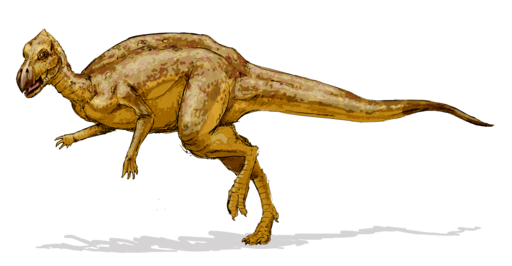FOR AGES 3 YEARS TO 18 YEARS
Magnamanus was a type of basal iguanodontian dinosaur. The name means large or big hand and is in reference to the unusually big hands of the dinosaur. The specific name Magnamanus soriaensis refers to the origin of the dinosaur in Soria. The history of the genus dates back to the Early Cretaceous period. Magnamanus lived in Spain, Europe during the Cretaceous period.
The name Magnamanus is pronounced as 'Mag-na-ma-nus'.
The Magnamanus soriaensis is a type of Ornithischian dinosaur that lived in the region which is known as Spain.
Magnamanus evolved either during the Hauterivian age or the Barremian age of the upper Cretaceous.
The Magnamanus soriaensis lived between the Hauterivian and Barremian ages of the Cretaceous period, they went extinct around 130 million years ago.
The fossils of Magnamanus were discovered from the Golmayo Formation of Spain in Europe located a few miles west of Soria.
The habitat around the Golmayo Formation of Europe was a bit marchy, therefore it is believed that they preferred marshy habitats.
The bones of Magnamanus soriaensis were not found in association but they belonged to a single skeleton of a single dinosaur. This implied that they did not live with other dinosaurs.
The collected remains of the species suggest that they lived 130 million years ago in Europe.
Like other dinosaurs, a Magnamanus reproduced by laying eggs.
The Magnamanus was a large herbivore ornithopod with unusually broad hands. Their large hands had a protruding thumb vertebra and the fifth finger like other dinosaurs of the Iguanodontia clade. The dinosaurs were also described based on their skull shape and postcranial remains.

The collected remains of the partial skeleton of the Magnamanus reveal a skull, a neck rib, lower jaw, 62 teeth of the upper jaw, and parts of the vertebrae.
Similar to other dinosaurs, a Magnamanus soriaensis communicated through different vocalizations.
The length of a Magnamnus is between 29.5-30.8 ft (9-9.3 m). They were two times bigger than Phosphatodraco.
The speed of Magnamanus dinosaurs had not been evaluated currently by examining their skeleton but because they had a great height and weight, they were considered to be slow.
The weight of the Magnamanus was around 6613 lb (2999.60 kg).
The male and the female were both referred to as Magnamanus soriaensis.
A baby Magnamanus was called a nestling or a hatchling.
The Magnamanus had a herbivorous diet. As a herbivore, it was less aggressive than flesh-eating predators.
The generic name is a combination of Latin words magnus meaning large and manus meaning hand.
*We've been unable to source an image of Magnamanus and have used an image of Edmontonia instead. If you are able to provide us with a royalty-free image of Magnamanus, we would be happy to credit you. Please contact us at [email protected]
*We've been unable to source an image of Magnamanus and have used an image of Zalmoxes instead. If you are able to provide us with a royalty-free image of Magnamanus, we would be happy to credit you. Please contact us at [email protected]
Read The Disclaimer
At Kidadl we pride ourselves on offering families original ideas to make the most of time spent together at home or out and about, wherever you are in the world. We strive to recommend the very best things that are suggested by our community and are things we would do ourselves - our aim is to be the trusted friend to parents.
We try our very best, but cannot guarantee perfection. We will always aim to give you accurate information at the date of publication - however, information does change, so it’s important you do your own research, double-check and make the decision that is right for your family.
Kidadl provides inspiration to entertain and educate your children. We recognise that not all activities and ideas are appropriate and suitable for all children and families or in all circumstances. Our recommended activities are based on age but these are a guide. We recommend that these ideas are used as inspiration, that ideas are undertaken with appropriate adult supervision, and that each adult uses their own discretion and knowledge of their children to consider the safety and suitability.
Kidadl cannot accept liability for the execution of these ideas, and parental supervision is advised at all times, as safety is paramount. Anyone using the information provided by Kidadl does so at their own risk and we can not accept liability if things go wrong.
Kidadl is independent and to make our service free to you the reader we are supported by advertising.
We hope you love our recommendations for products and services! What we suggest is selected independently by the Kidadl team. If you purchase using the buy now button we may earn a small commission. This does not influence our choices. Please note: prices are correct and items are available at the time the article was published.
Kidadl has a number of affiliate partners that we work with including Amazon. Please note that Kidadl is a participant in the Amazon Services LLC Associates Program, an affiliate advertising program designed to provide a means for sites to earn advertising fees by advertising and linking to amazon.
We also link to other websites, but are not responsible for their content.
Was this article helpful?



We’ll send you tons of inspiration to help you find a hidden gem in your local area or plan a big day out.



Check your inbox for your latest news from us. You have subscribed to:
Remember that you can always manage your preferences or unsubscribe through the link at the foot of each newsletter.